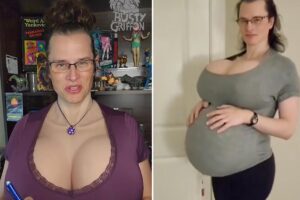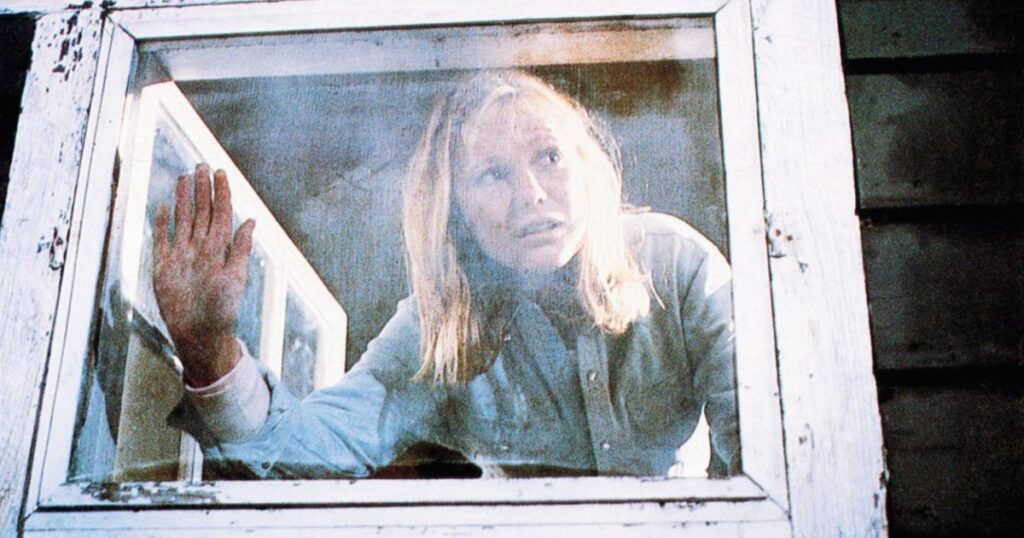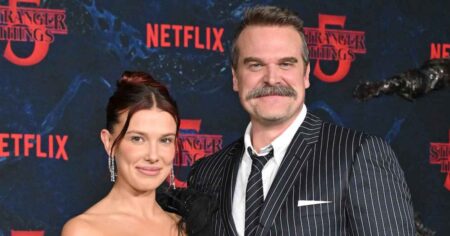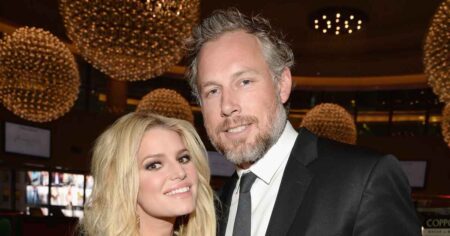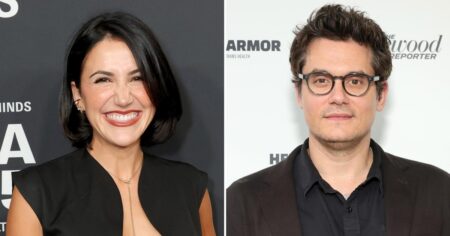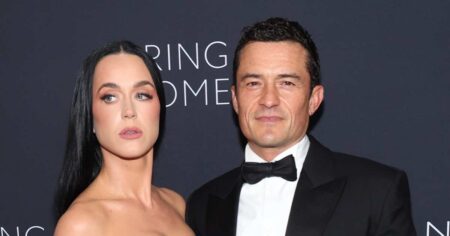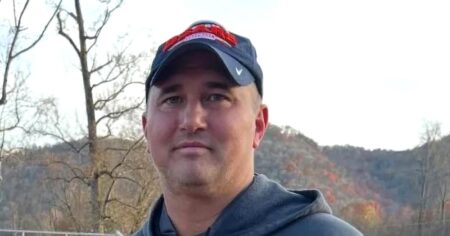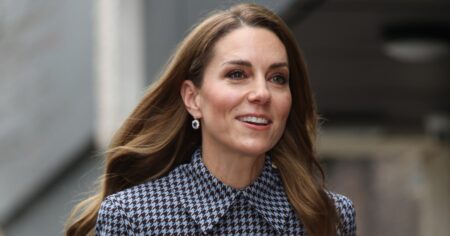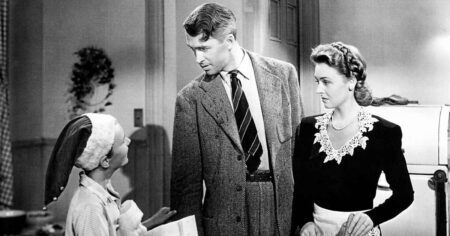It’s always the right time to watch a good horror movie. But October is prime spooky season, and to stream a merely OK horror movie just seems wrong.
To avoid doing the scariest month of the year dirty, Watch With Us has compiled a list of the 10 best horror movies of the 1980s, when the genre was at its peak in popularity, output and quality.
While some fan-favorites didn’t make the cut (sorry, A Nightmare on Elm Street!), plenty did, with an appropriately terrifying assembly of masked killers, flesh-eating zombies, ghosts, ghouls and John Carpenter movies faithfully representing the best the genre had to offer in the Regean era.
10. ‘Demons’ (1985)
Movie theaters are supposed to be safe spaces, right? Well, not in Lamberto Bava’s world. The Italian director set his seminal zombie classics, Demons, almost entirely in a single-screen theater in Berlin, where moviegoers get a lot more than they bargained for when they attend a free screening. When one patron is cut by a mysterious metallic mask displayed in the lobby, she turns into a demon. Chaos ensues, with a lot of the film’s cast turning into the undead or being ripped apart by them. At some point, a helicopter crashes into the theater. It’s that kind of film.
With a barely-there plot, paper-thin characterization and English dubbing that’s borderline laughable, Demons really shouldn’t work. But what saves the film is the still-impressive makeup effects, which depict in graphic detail scalps being ripped from heads and guts spilling out of split-open stomaches. Then there’s the messed-up narrative, which keeps upping the ante on how bad things can really get. Demons is totally insane, and that’s what makes it one of a kind.
9. ‘Lady in White’ (1988)
Lady in White is probably the gentlest horror movie ever made. When 9-year-old Frankie (Lukas Haas) is locked in his classroom coatroom on Halloween night, he thinks he sees the ghost of a little girl before being nearly strangled to death by an unseen assailant. Frankie survives and learns that the little girl is the latest victim of a serial killer targeting young children. If Frankie can’t find out who the killer is, he could be his next victim.
Set in small-town America circa 1962, Lady in White effectively uses its idyllic period to underline the truly terrible things that lie just beneath the surface. Haas is terrific as a junior boy detective who knows more than most adults and keeps getting ignored due to his size. The film’s climax combines true terror and dramatic lyricism in ways most films in the genre could only dream of.
8. ‘The Blob’ (1988)
Who would’ve thought a remake of the 1958’s The Blob would be so effective — and so gross? A minor hit when it was first released, the sci-fi/horror redo has grown in critical stature over the years, and it fully deserves its cult classic status. The film’s creative use of practical effects and its take-no-prisoners approach in depicting how the blob doesn’t care who it kills make this movie just as terrifying and unrelenting as more praised genre flicks like Aliens and The Terminator.
When a meteor crashes in an isolated field, a homeless man discovers a small jelly-like substance at its center. The alien entity soon consumes him and everyone else in its path, growing exponentially until it threatens the entire town. Only cheerleader Meg (Shawnee Smith) and biker Brian (Kevin Dillon) know the Blob’s weakness — it can’t stand the cold. But as the Blob grows bigger after each kill, will that be enough to stop it?
Directed by Chuck Russell, The Blob is funny, frantic and fast-paced, which is exactly what you need in a movie called The Blob. There are several action setpieces, like one in a nearly empty diner and another in a crowded movie theater, that top anything made in the ‘80s — and even today. The practical effects are effectively gory, and answer any questions you might have about what it would look like if someone were pulled through a kitchen sink drain pipe. (It’s not pretty, folks.)
7. ‘Friday the 13th Part II’ (1981)
Among the major horror franchises, Friday the 13th gets the least amount of respect. Its formula is too simple, its aims are too basic and it’s frequently more of a collection of carefully orchestrated deaths rather than a truly scary narrative. But the first four movies hold up surprisingly well, and the best of the lot is Friday the 13th Part II, which delivers the most scares per minute thanks to some surprising kills and an unsettling, burlap-sack-wearing killer.
Five years after the events of the original, a new group of teenagers arrives at Camp Crystal Lake to prepare for a new summer season. Unsurprisingly, they are killed one by one, with only Ginny (Amy Steel) possessing enough survival instincts to realize what’s going on. She’s the only one who can stop this mysterious killer, who might just be Jason Vorhees, the son of the woman who killed all those camp counselors in the original.
6. ‘The Return of the Living Dead’ (1985)
Less of a sequel and more of a punk homage to George Romero’s 1968 classic, The Return of the Living Dead focuses on a band of teenagers partying in a graveyard on a hot summer night. They inadvertently awaken the dead, who are quicker and deadlier than their zombie forefathers. Their only sanctuary is an isolated mortuary and an empty warehouse, but is that enough to ward off a seemingly never-ending horde of brain-eating monsters?
The answer is a resounding no. What’s so scary about The Return of the Living Dead isn’t necessarily the zombies themselves — although they are plenty terrifying to look at — but rather what they represent. When someone talks to a captured zombie and asks why they need to consume human flesh, the zombie responds by saying it’s the only thing that alleviates the pain of death. That’s really frightening!
What’s also unsettling is the film’s nihilistic ending, which somehow incorporates a Dr. Strangelove-inspired deus ex machina that wipes out the zombie problem — and everyone else, too. The movie’s humor is so dark that the final shot indicates the zombies aren’t dead after all — the cycle of violence will continue, and we’re all doomed to be eaten.
5. ‘The Fog’ (1980)
The Fog is one of those movies you have to experience rather than explain. Is it scary? Not really. Is it the greatest horror movie of the decade? Hardly. But like the titular weather phenomenon, it slowly creeps in on you until you can’t think of much else.
Set in Antonio Bay, The Fog chronicles the sleepy California coastal town’s upcoming centennial celebration, which involves a local DJ, Stevie Wayne (Adrienne Barbeau), a priest with a secret (Hal Holbrook) and a mysterious hitchhiker (Jamie Lee Curtis). A killer fog bank brings these disparate people together, and soon they realize an ancient curse is about to be unleashed as Antonio Bay turns 100. They’ll have to find a way to reverse it, or else the ever-approaching fog that has killed several people will consume them, too.
The Fog’s story is a big bunch of hooey, but that doesn’t matter much when the mood is this spooky. Credit director John Carpenter, who knows when to use silence — and a nicely placed musical score cue — to conjure up all sorts of dread. The Fog is the best example of a horror movie that works purely on vibes alone, and with Carpenter behind the camera, that’s enough.
4. ‘The Shining’ (1980)
Stephen King is wrong. The horror novelist famously didn’t like what Stanley Kubrick did to his 1978 novel and called it “a maddening, perverse and disappointing film.” Yes, The Shining is maddening and perverse, but in ways that make it truly one of the most chilling movies ever made.
When Jack Torrance (a rightfully unhinged Jack Nicholson) takes a gig caretaking for a Colorado resort during the winter off-season, he sees it as an opportunity to reconnect with his wife, Wendy (Shelly Duvall, vulnerable and terrific) and son, Danny (Danny Lloyd), as well as finish his novel. But what he gets instead is frequent encounters with the hotel’s ghosts, who want him to do some very bad things to his family. As Jack slowly descends into madness, Wendy and Danny must find a way to save him and escape the resort before it’s too late.
From its brilliant opening tracking shot of the Torrances’ traveling on a lonely mountain highway to the chilly climactic chase through a seemingly never-ending snowy maze, The Shining contains so many indelible visuals that they’ve since become pop culture landmarks. That doesn’t mean, though, that they still don’t invoke a particular sense of horror at being isolated with a loved one who has lost his mind. The Shining wouldn’t work without Kubrick’s very deliberate cold direction. This is a film that lacks all warmth and passion; in its place is emptiness, spiritual and physical, and the fear of the unknown.
3. ‘Halloween II’ (1981)
Halloween II is probably the horror sequel that everyone likes to criticize. Any follow-up to Carpenter’s seminal horror masterpiece would’ve been met with its fair share of criticism, but Halloween II seemed to pay for the sin of not being as great as the original. But what horror movie is? If you take it for what it is — a slasher movie with some gnarly kills and a doozy of a plot twist — it’s not only fun, but also one of the more inventive films in the genre.
Set on the same Halloween night as the original, Halloween II follows a traumatized Laurie Strode (Jamie Lee Curtis in the world’s worst wig) as she checks into Haddonfield Memorial Hospital to heal from her injuries. Michael Myers still wants to kill her, though, and he’ll slaughter as many doctors, nurses and horny ambulance drivers to do so.
From that creepy intro (“You don’t know what death is!”) to the fiery climax, which sees the embodiment of evil turned into a literal human torch, Halloween II starts at a 9 and never lets up. It’s as relentless as Michael himself — just when you want to breathe easy and relax, another gruesome murder occurs. Is it as artful as 1978’s Halloween? No. But Halloween II is a different kind of horror movie, a slasher that convincingly argues that in this case, quantity is better than quality.
2. ‘Poltergeist’ (1982)
Leave it to Steven Spielberg to find the horror lurking in America’s suburbs. The E.T. filmmaker didn’t direct Poltergeist — Tobe Hopper is credited as the official helmer— but his presence is all over this modern-day gothic tale of a family being besieged by — you guessed it — a poltergeist.
When young daughter Carol Anne (Heather O’Rourke) disappears one dark, stormy night, her parents realize she’s been kidnapped by ghosts that need her to cross over to the afterlife. Desperate, they bring in a pint-sized spiritual medium (Zelda Rubinstein), who is their last, best chance to get Carol Anne back.
While it’s rated PG, Poltergeist is utterly terrifying because it preys upon multiple commonplace fears like dolls suddenly coming to life, sentient trees that suddenly want to eat you, monsters that lurk in closets and beneath beds and — worst of all — clowns.
Yet what’s truly great about Poltergeist is that it dares to offer a glimpse of what the afterlife could look like — filled with blinding light and creatures so bizarre and frightening they turn a character’s hair white. Some credit should be given to composer Jerry Goldsmith, who creates a symphony of the supernatural that’s equal parts transcendent and scary AF.
1. ‘The Thing’ (1982)
John Carpenter is the king of ‘80s horror, and a case could be made for a number of his movies to be in this slot, like Christine, The Fog or Prince of Darkness. I went with The Thing because it’s the one that keeps me up at night the most.
At a remote research station in Antarctica, a group of Americans encounters an alien organism, a “thing,” that can imitate any life form it comes into contact with. Determined to isolate it to prevent further harm, they have to battle their own paranoia — is one of them the thing in hiding? — as well as dwindling supplies and terrible weather. As the thing escapes and begins to assimilate members of the station, it’s up to R.J. MacReady (Kurt Russell) to kill the creature to stop it from invading civilization, even if it means his own death.
A remake of the 1951 classic The Thing From Another World, The Thing improves on the original in just about every way. Utilizing state-of-the-art special effects, which still causes audiences to glance away in disgust, Carpenter makes what was once subtle into a visceral horror show that puts the “horror” into “body horror.” Want to see someone’s arms getting chopped off by an open chest cavity that suddenly transforms into jaws? Then The Thing is for you.
But The Thing isn’t all just blood, guts and disembodied alien body parts. It’s also a fine thriller that plays off the shared suspicion that you can never really know another person. The sequence when MacReady tests each station member’s humanity via a blood sample is one of the tensest scenes ever put on film, and the movie’s bleak, open-ended climax is the perfect way to end the best horror movie of the decade. The ultimate horror of The Thing is that, despite everyone’s best intentions, the monster that lives among us will get out eventually. It’s only a question of when — not if — and if that doesn’t scare you, nothing will.
Led by Senior Editor and experienced critic Jason Struss, Watch With Us‚Äô team of writers and editors sees almost every movie and TV show from the distant past to the present to determine what‚Äôs worth your time and money. Our countless hours of multimedia consumption ‚Äî combined with years of experience in the entertainment industry ‚Äî help us determine the best movies and TV shows you should be streaming right now.¬Ý
¬Ý
To be considered “the best,” these films and series can be visually engaging, intellectually stimulating or simply just fun to watch, but the one trait they must have is that they are all, in some way, entertaining. We then check which platform they are streaming on and how you can access them as a subscriber. No algorithm nonsense or paid endorsements here — our recommendations are based purely on our love and interest for the films and shows we love.
Read the full article here



